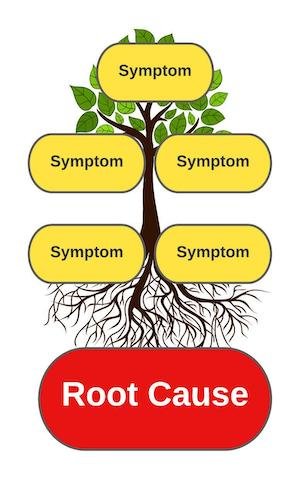Using the 5 Whys to Discover Root Cause of Medical Device Defects with Seinfeld Gifs Just Because
In the high-stakes world of medical device manufacturing, even a single misstep can have catastrophic consequences—impacting not just a company's bottom line, but more critically, the safety and well-being of the people who depend on these life-saving devices. This industry is heavily regulated, with stringent standards set by bodies such as the FDA to ensure product safety and efficacy. While failing an FDA audit can seriously harm a business, the real cost comes from compromising the safety and well-being of patients.
In this field, accuracy and precision aren't merely goals; they're absolute necessities, as the repercussions of errors can be profound and irreversible.
So, what happens when processes falter and defects inevitably creep in? Instead of rushing to apply quick fixes, it's essential to take a deep, analytical dive to uncover the problem at its’ root cause. By thoroughly understanding and addressing these underlying issues, we can implement solutions that are both effective and sustainable.
In this article, we'll delve into Root Cause Analysis and the 5 Why Approach, all while sprinkling in a touch of Seinfeld humor to keep the journey both enlightening and entertaining.
What is Root Cause Analysis?
Root Cause Analysis (RCA) is a systematic method used to identify the underlying reasons for problems or defects, enabling organizations to implement effective solutions and prevent recurrence. By drilling down to the core issues rather than just addressing surface-level symptoms, RCA helps maintain high standards of quality, efficiency, and safety, particularly critical in industries like medical device manufacturing. One widely recognized and straightforward RCA tool is the 5 Why Approach.
Dig up the roots of organizational problems.
The 5 Why Approach
The 5 Why Approach involves asking "Why?" five times (or as many times as necessary) to peel back the layers of symptoms and get to the heart of a problem. Each answer forms the basis for the next question, creating a causal chain that leads to the root cause. This method is particularly effective because it encourages deeper thinking and analysis, helping teams move beyond quick fixes to implement lasting solutions.
Why Seinfeld References?
You might wonder be wondering, James, why are you weaving Seinfeld references into a serious analysis of medical device assembly? As Jerry (or Kramer) would say, "What's the deal with that?" I don’t really have another an answer to that question, besides that it brought me joy. So, let's dive into this root cause analysis with a little help from our friends Jerry, George, Elaine, and Kramer—because, frankly, it just feels right.
I’m glad you asked, Jerry.
Problem Statement
❌❌ 9.7% of blood glucose meters are being rejected for rework at Kramer’s NYC Assembly facility, a startup location, indicating a significant gap from the standard condition of 0.8%. These defective meters result in Non-Compliance Reports (NCRs), which are formal documents used to report, investigate, and address any deviations from specified requirements or standards. ❌❌
NCRs necessitate rework and are critical for maintaining quality control and regulatory compliance. In the medical device industry, any deviation or error can compromise the device's reliability, leading to potential harm to patients and liability issues for the company.
Let’s use the 5 Why Approach to Discover the Root Cause
🔍 WHY are 9.7% of blood glucose meters being rejected for rework at Kramerica’s Upper West Side (“UWS”) Assembly facility, indicating a significant gap from the standard condition of 0.8%???
WHY? Kramerica’s UWS facility assembly line workers ARE NOT adept at assembly.
Explanation: In the medical device industry, being "adept at assembly" consists of possessing the skills and precision to handle sensitive components and follow strict protocols to ensure the devices are safe and effective for patient use. This includes correctly assembling tiny, intricate parts, ensuring proper calibration, and following sterilization procedures to prevent contamination.
ANY deviation or error can compromise the device's reliability, leading to potential harm to patients and liability issues for the company. Additionally, it requires workers to be vigilant and methodical, adhering to exact specifications and quality control measures to ensure each device functions as intended.
It’s like when George tried to assemble the Frogger machine for transport and failed miserably because he didn't know how to handle it properly!
George is not great at solving problems in the real world.
2. WHY? They haven’t received training on updated assembly methods and Lean layouts.
Explanation: Updated assembly methods for blood glucose meters include:
☑️ Upgraded automation ☑️ Precise component placement using robotic assistance ☑️Updated calibration techniques to ensure accuracy.
These methods often involve the integration of sophisticated software to monitor and control the assembly process, minimizing the opportunity for human error and improving the process’s effectiveness.
Think of it like when Kramer tried to manage Rickshaw drivers without understanding the intricacies—chaos ensued!
Similarly, without proper training in these updated methods, assembly workers are bound to make errors.
Safety first, guys. Sigh.
A Lean layout focuses on streamlining processes to eliminate waste and improve efficiency. This involves organizing workstations to minimize movement and handling, ensuring a smooth flow of materials and information, and emphasizing a clean, organized workspace that supports quality and safety standards.
For example, tools and parts are positioned within easy reach, assembly steps are clearly defined, and visual aids guide workers through the process. It's like the "No soup for you" episode—if the process isn't followed precisely, there's no product for you!
Soup Nazi in all his glory.
3. WHY? The training and development manager works at Del Boca Vista HQ and has not visited NYC to train the team.
Explanation: Although the training and development manager was able to visit other sites, maintaining their defect rates within the standard condition of 0.8%, the absence of training at the UWS facility has prevented workers from receiving essential guidance and skill development, directly impacting their ability to meet quality standards.
The complexity of the work means that virtual training alone is insufficient; hands-on practice and direct supervision are critical for mastering the intricate assembly processes required for high-quality medical devices. Without this, it's like pretending to be an architect named Art Vandelay—without the necessary skills, the results are bound to be subpar!
Art Vandelay.
4. WHY? Senior leadership mandated a 20% reduction in travel costs, so the training and development manager had to postpone the visit for several months.
Explanation: Because of a cost-cutting mandate from senior leadership, essential training sessions at the UWS facility were delayed indefinitely.
Ideally, this critical visit SHOULD NOT have been included in the budget reductions. However, because the budgeting process WAS NOT clearly communicated, it fell through the gaps, much like Kramer's chaotic adventures.
Kramer and Newman showcasing how “the sausage” is made.
5. WHY? The company's budgeting process required prioritizing immediate cost savings and lacked a Hoshin Kanri or strategy deployment process to ensure proper budgeting and communication throughout the enterprise.
Explanation: The absence of a Hoshin Kanri (strategy deployment) process meant that budgeting decisions were not properly conducted or communicated across the organization. This led to short-term cost-saving measures being prioritized without a comprehensive understanding of their long-term impact on quality and training.
Root Cause
❌❌ The company's budgeting process, which prioritized immediate cost savings out of necessity, combined with a lack of a Hoshin Kanri process to ensure the effective alignment and deployment of the company’s strategy. ❌❌
Potential Countermeasures
To address the root cause, it's essential to implement a more strategic and holistic budgeting process. Integrating a Hoshin Kanri process will ensure that strategic goals align with financial decisions, providing clarity and direction throughout the enterprise. This will help prioritize critical training sessions and investments that directly impact product quality.
Additionally, upgrading remote training solutions like webinars and VR training can mitigate the impact of rising travel costs. While hands-on, learn-by-doing training is critical, these remote solutions can complement in-person training, ensuring workers stay updated with the latest assembly methods and standards. Cross-training staff and developing mentorship programs can build a more versatile and resilient workforce, capable of maintaining high-quality standards even in the face of budget constraints.
Summary
Ensuring we get to the root cause before implementing countermeasures is crucial—hasty solutions can often exacerbate problems, much like George's ill-fated attempts at Frogger or Kramer's litany of chaotic schemes. By addressing the underlying issues, we can implement lasting, effective solutions that prevent future complications, ensuring our products meet the highest standards.
By aligning our strategic goals with budget allocations and maintaining clear communication, we can navigate the complexities of medical device assembly with the precision and confidence reminiscent of George's high score on Frogger—operational excellence.
#rootcauseanalysis #medicaldevices #rootcause #problemsolving #fivewhys #operationalexcellence

















